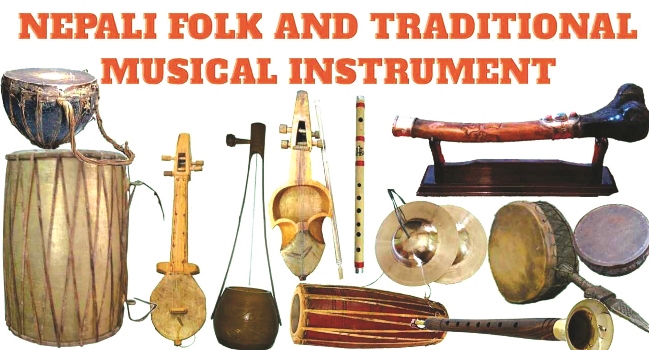Folk Music By The Folks, For The Folks

Balaram Chaulagain
Music is an art and a cultural activity that expresses ideas and emotions in a significant form through elements of rhythm, melody, and harmony. From time immemorial, music has been chosen as a source of amusement and recreation for inhabitants residing across the length and breadth of this universe.
Folk music is created in a rural community where a major chunk of mundane people resides. Folk songs (music) represent a genuine image of any localised area with the theme 'for the and by the people'. With more than fifty ethnic groups, the country's music is highly diverse. The Tamang Selo, Sorathi, Chyabrung, Dhan Nach, Maithali, and many other songs are quite popular. There are numerous less common genres of folk songs that are yet to be recognised and explored.
Various Styles
Folk music also embraces various song styles, musician families, and traditions such as ceremonial, classical, semi-classical and folk and such others.
There are many singers, musicians, and instrumentalists associated with these particular styles and forms. Some musicians being incredibly popular owing to their distinctive contribution and charisma have created a massive following, in the process themselves becoming folk heroes and icons of Nepali music.
With this distinctive style of musical performance, Kumar Basnet, Jhalakman Gandharba, Dharma Raj Thapa, Ram Thapa, and other popular folk singers are well-liked among Nepali speaking people across the globe. They contributed to and popularised the peculiar tradition and style of singing folk songs by using the rod-like one-string instrument (Tungna), flute, Madal, and other locally made musical instruments.
In addition to this, many more old folk singers have developed the existing style and introduced it to the genre of Nepali folk music. Music in Nepal displays diverse variety, trends, styles, presentations, gadgets, backgrounds, themes, and ranges.
Besides, it holds various singing methods, the background of contemporary musicians' relations and ethnicities such as traditional, orthodox, folk, and such others.
Music in Nepal has evolved and come a long way. Nepali musical field includes folk, modern, and national songs among which folk songs are more popular and widely appreciated. Besides, classical, pop and rock music/songs are also equally common in Nepalese society. Cultural songs belonging to ethnic groups of Nepal are also a part of folk songs.
Some prominent cultural songs of Nepal are the Newari, Maithali, Tamang Selo, Tharu, Sherpa, and many tribal songs.
Some folk songs belong to the dohori (duet) form, which is a kind of dual between two groups of singers.
The folk duet (dohori) is one such genre of songs based on traditional norms and values of the Nepali society. It is based on debate taking place between two groups of people. People debate in songs with distinct rhythm and wit. The cadence of dohori songs is maintained by the debaters or rival singers, while they prove a point to the opposition. The folk songs based dual is sung between the two groups of boys versus girls against each other.
Usually, such songs are initiated by one group of boys on a particular topic to which the other groups of girls reciprocate with meaningful musical dialogues with an expressive answer.
It is known to all that Nepalese are used to listening to familiar folk songs that feature alternating female and male voices responding to one another.
Folk Duets/ Teej Songs
The lok dohori (Folk duet) was originated among the Gurung community in Western Nepal with its age-old tradition of a Rodhighar (the traditional dance hall).
After a hard day of harvests on the terrace farms, young boys and girls of the same area challenge each other in Rodhighar with duets in which the musical repartee has to come up with a suitable answer within a few seconds.
Besides, every Teej festival-related folk songs also carry significant issues of migration, patriarchy, or other social irregularities of society and government sector. Once a year, Teej is traditionally celebrated by Hindu women all over Nepal and abroad. Married women observe this festival for the well-being of their husbands. Sometime Teej songs move beyond love affairs and contemporary issues. The theme of lyric chosen in Teej songs manifests the clear reality and agony being faced by women and their empowerment as well as social injustice prevailed.
The Nepali hit folk songs of current time are plentiful in numbers and among them are Babari Phoolko Boat, Bhijo Timro Rato Pacchauri, Tansen Ghamailo, Malai Khutrukkai Paryo Jethan. Nowadays, there are complaints about folk songs becoming too commercial and some songs having a political tone instead of being entertaining and amusing.
Explicit Songs
Provocative and explicit folk songs are detrimental to the social fabric of our cultural values and norms. Controversial and sub-standard folk songs must be avoided otherwise it may spoil the sentiments of our social values and norms. Let us hope in the days to come folk song collectors, singers, and musicians will create original thought-provoking, romantic, and entertaining folk songs for the welfare of society. Rampant and frequent listening of rude and sub-standard folk songs may spoil the thinking of citizens.
(A retired public health officer, Chaulagain keeps a close tab on Nepali folk music)
Recent News

Do not make expressions casting dout on election: EC
14 Apr, 2022
CM Bhatta says may New Year 2079 BS inspire positive thinking
14 Apr, 2022
Three new cases, 44 recoveries in 24 hours
14 Apr, 2022
689 climbers of 84 teams so far acquire permits for climbing various peaks this spring season
14 Apr, 2022
How the rising cost of living crisis is impacting Nepal
14 Apr, 2022
US military confirms an interstellar meteor collided with Earth
14 Apr, 2022
Valneva Covid vaccine approved for use in UK
14 Apr, 2022
Chair Prachanda highlights need of unity among Maoist, Communist forces
14 Apr, 2022
Ranbir Kapoor and Alia Bhatt: Bollywood toasts star couple on wedding
14 Apr, 2022
President Bhandari confers decorations (Photo Feature)
14 Apr, 2022










